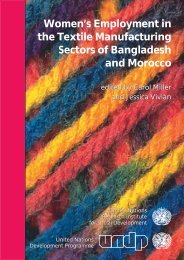Beyond Pragmatism: Appraising UN-Business Partnerships
Beyond Pragmatism: Appraising UN-Business Partnerships
Beyond Pragmatism: Appraising UN-Business Partnerships
Create successful ePaper yourself
Turn your PDF publications into a flip-book with our unique Google optimized e-Paper software.
<strong>UN</strong>RISD PROGRAMME ON MARKETS, BUSINESS AND REGULATION<br />
PAPER NUMBER 1<br />
Development. 32 According to Broadwater and Kaul (2005), there are estimated to be around 400<br />
global public-private partnerships that address global concerns—such as control of<br />
communicable diseases, the fight against world poverty and hunger, and climate stability—<br />
compared with 50 in the mid-1980s.<br />
Agencies such as <strong>UN</strong>ICEF and WHO report that they have entered into approximately 1,000<br />
and 90 “partnerships” or “alliances”, respectively, in recent years, although the types of<br />
collaborations involved vary considerably. Unlike WHO, <strong>UN</strong>ICEF has actively sought corporate<br />
funding to support various initiatives. 33 In 2005, the organization received individual<br />
contributions of US$100,000 or more from approximately 250 companies, with total proceeds<br />
received through the corporate sector amounting to US$142 million. 34 The United Nations<br />
Commission on Sustainable Development listed 341 partnerships as of May 2006. <strong>UN</strong>DP’s<br />
Public-Private <strong>Partnerships</strong> for the Urban Environment (PPUE) currently lists 396 partnerships<br />
between local government, business and communities to increase the access of the urban poor<br />
to basic services such as water, sanitation, solid waste management and energy. 35<br />
<strong>UN</strong>DP has many partnerships in other programmes. For example, it plays a<br />
brokerage/facilitating role to foster the growth of small businesses through its Growing<br />
Sustainable <strong>Business</strong> (GSB) initiative that is currently active in seven developing and<br />
transitional countries. 36 The work is focused on five sectors—financial, energy, water and<br />
sanitation, telecommunications and agriculture. <strong>UN</strong>DP, together with <strong>UN</strong>EP and the World<br />
Conservation Union (IUCN), has established Supporting Entrepreneurs for Environment and<br />
Development (SEED), a partnership that fosters The Seed Associate Partners Network (Steets<br />
2006). 37<br />
<strong>UN</strong>EP has various partnerships initiatives. As indicated above, it is involved with <strong>UN</strong>DP and<br />
IUCN in the Seed Initiative. It also promotes local-level public-private initiatives to improve<br />
public services by providing clean drinking water and reliable energy services to poor<br />
consumers while at the same time contributing to environmental objectives (<strong>UN</strong>EP no date:7–8).<br />
<strong>UN</strong>EP also has policy-type partnerships, as, for example, the <strong>UN</strong>EP Finance Initiative (<strong>UN</strong>EP<br />
FI). 38 This constitutes one of <strong>UN</strong>EP’s major partnership efforts, bringing together global<br />
financial institutions, including commercial and investment banks, insurance and reinsurance<br />
companies, fund managers, multilateral development banks, and venture capital funds. The<br />
aim is to develop and promote the linkage between the environment and financial performance<br />
by developing and applying voluntary guidelines on key environmental concerns, and to<br />
influence relevant international policy. Between 1992 and 2004, <strong>UN</strong>EP FI has grown from six<br />
banks to 217 financial institutions (Holz 2004).<br />
In the field of health, WHO is involved in some 90 partnerships covering a variety of<br />
collaborations. 39 The International Federation of Pharmaceutical Manufacturers and<br />
Associations (IFPMA 2006) lists and describes 92 “<strong>Partnerships</strong> to Build Healthier Societies in<br />
the Developing World”, which are said to include the “vast majority” of such initiatives.<br />
The International Labour Organization (ILO) is a rather different case in that it is a tripartite<br />
structure that gives equal voice to governments, employers and workers, and considers itself to<br />
be a public-private partnership. Its activities to promote labour standards, the Fundamental<br />
32<br />
33<br />
34<br />
35<br />
36<br />
37<br />
38<br />
39<br />
Type II partnerships refer to those that are not negotiated between member states of the <strong>UN</strong>.<br />
A core element of <strong>UN</strong>ICEF’s strategy vis-à-vis the business sector is to promote corporate investment in children, be it through<br />
<strong>UN</strong>ICEF programmes or other organizations (personal communication with Anne-Marie Grey, <strong>UN</strong>ICEF, 7 September 2006).<br />
Personal communication with Anne-Marie Grey, <strong>UN</strong>ICEF, 7 August 2006; <strong>UN</strong>ICEF 2005. For a list of several of the companies<br />
involved, see www.unicef.org/corporate_partners/index_25124.html.<br />
See http://pppue.undp.org/index.cfm?module, accessed on 14 June 2006.<br />
www.undp.org/business/gsp/about.htm, accessed on 10 July 2006.<br />
See also www.seedinit.org, accessed in July 2006.<br />
Hölz 2004. See also www.unepfi.org, accessed on 4 August 2006.<br />
Personal communication from Derrick Deane, WHO, 15 August 2006.<br />
14
















